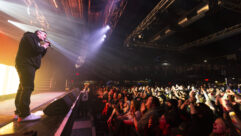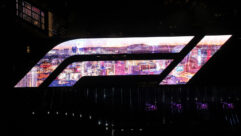
First Wayne Street United Methodist Upgrades with Bose RoomMatch Pt. 1
Oct 9, 2014 10:34 PM,
With Bennett Liles
Listen to the Podcast

Editor’s note: For your convenience, this transcription of the podcast includes timestamps. If you are listening to the podcast and reading its accompanying transcription, you can use the timestamps to jump to any part of the audio podcast by simply dragging the slider on the podcast to the time indicated in the transcription.
From Sound & Video Contractor Magazine, this is the SVC Podcast with Phil Mitchell of the Mitchell Design Group. Show notes for the podcast can be found on the web site of Sound & Video Contractor Magazine at svconline.com.
Churches can be tough to get right on sound and when the Wayne Street United Methodist Church in Fort Wayne, Indiana needed an upgrade they went with a Bose RoomMatch system installed by the Mitchell Design Group. Phil Mitchell is here to tell us how the old system came out and the new one went in. That’s coming right up on the SVC Podcast.
Phil, thanks so much for being here with us from the Mitchell Design Group in Kokomo, Indiana. Tell us a little something about the Mitchell Design Group. What do you there and what sort of projects have you got going on?
Well, Mitchell Design Group is kind of a reincarnation of a company that I participated in earlier called Audio Experts International. I actually closed that company down for family reasons, to spend more time at home with my family instead of traveling the country. I participated in a family business for awhile and with my kids grown and on their own now I decided to get back into the pursuit of what I love. This is kind of My Career Act II, so to speak, and keeping it lower profile at this point. I try to focus on projects that are a little more close to home than what I used to do. We concentrate mostly on the house of worship market, but also do secondary schools and we’ve done oh, a variety of projects – museums; anything to do, really, with audio and video projection we are more that willing to take a look at. [Timestamp: 1:54]
Probably better the second time around with the benefit of previous experience. On this one we’ve got the Wayne Street United Methodist Church in Ft. Wayne. Are they more traditional or do they have live music?
Wayne Street is kind of typical of a lot of Methodist churches in that they try to do a little bit of contemporary worship and then they have traditional, but the church itself is very traditionally oriented. They have a pipe organ in the balcony. All of the surfaces in the room are hard. The ceiling is drywall, the walls are brick and the floor is terrazzo. So we had some interesting challenges there. They had a very traditional form of worship for the most part and we tried to address the situation kind of as it was, really. [Timestamp: 2:46]
That’s so often what you have to deal with on church sound projects. They want it to sound fairly lofty like you would expect and you need a system that works for intelligibility but makes the music sound good, too.
Right. Exactly. That was kind of the challenge presented to us, was the pipe organ was really the focal point of the room itself and they purposely designed the room with that in mind and didn’t want to change the acoustics. So the challenge we were given was to try and make something work and integrate it into the room without changing the focus of the organ. Certainly a major part of their worship, but also they have some big orchestra there locally that comes in several times a year and does concerts as well and they’re part of a downtown Fort Wayne pipe organ tour. So it’s a primary focus of the room itself as well as the church. [Timestamp: 3:41]
And when you’re people got in there, they had a different job to do in getting the old system out and that can sometimes be tougher than you first figured.
Yes, actually that was interesting. That was one of those things that sometimes you don’t know until you start a job what all you’re getting yourself into and that was certainly a larger challenge than what we anticipated. The old box containing the woofer in the old system was separate components with the horns and a woofer and that was the original system, which had since been abandoned but never dismantled. It was mounted up inside a catwalk and when we got up in there we discovered that it was larger than the opening for the catwalk, so it wouldn’t allow us to lower it out of the way so we could choose our rigging points for the new system. So we had to actually dismantled it in place only to find out it was almost two-inch-thick plywood. I’ve never seen wood that thick and there was actually a note inside the woofer box as to when it was assembled in place and the date on there, so it was kind of an interesting history look at an old system that was, I’m sure, a challenge to install but even a bigger challenge to get out of the way. [Timestamp: 5:02]
Well, a lot of that old gear, if you can’t say anything else good about it at least some of it was very durable.
Yes. This one was certainly durable.
How long did you have to get this all done? What sort of timeframe were you working on? How did they manage to fit all of this in between services?
We actually blocked a week out and due to a number of things hung us up just a little bit – some unexpected issues of getting through conduit with wiring that was challenging as well as getting the old equipment down out of the way. We ran into the wrong lenses being shipped for the projectors and any number of things. We kind of pushed our envelope time-wise, but we were able to complete it right before they actually needed to use the – and honestly, they moved up a little bit the timeframe on us during the event. They had a conference that they were hosting that had forgotten to be on the calendar, so we were cut short work just a couple of days but we were still able to meet the demands of the room. [Timestamp: 6:04]
Oh, well it’s always fun having a few surprises on a project like this one.
Absolutely. Right.
And why did you decide to install the Bose RoomMatch system? I think the RM7010 is part of that?
Yes. There were two different Bose components used and a total of four speakers. Interestingly enough, the church had done their homework, done a good bit of research on their own knowing what their challenges had been in the past acoustically and what their goals were of trying to raise the intelligibility of the system. They had actually found the Bose system before they contacted me but in seeking proposals from local contractors they were dealing with a variety of different presentations coming back to them on whether it was going to be effective or not. And so they had seen an article in a magazine on a system that we had done previously using the Bose RoomMatch system and they wanted to talk to someone that had experience with that. So through a phone conversation and subsequent in-person meeting we were able to look at the room, look at what Bose had done in terms of their system design work and we felt very comfortable with it knowing what we were blessed, I guess, to know from our previous experience with that and that it would work very well in that room. We gave them a little bit higher comfort level, I think, in terms of that system selection by having had experience with it previously. [Timestamp: 7:35]
It’s great to have some real help from the manufacturer. Not all of them provide that and may sell you the stuff and say, “Take it and go.”
Absolutely, and that’s something that we have found that several manufacturers are really good about it, but Bose seems to have really taken that to heart in the way they’ve developed their company’s support systems and we’ve been very pleased with the level of support we got from them. [Timestamp: 8:00]
So, what about the other end of the audio chain? How do they mic everything? Have they got podium, wireless, headset mics?
Typical house of worship; they have a combination of things. They actually wanted to go completely wireless with their praise team. They had a few existing signs of wireless and we installed 10 new Audio-Technica, the handheld wireless with distribution amplifiers and antenna systems. So they’re fairly mobile with a large compliment of wireless including their existing headset. We do have a pulpit and lectern microphones and we installed Earthworks microphones there. But they do also do a good bit of recording, particularly with the pipe organ situation, so we installed some flying microphones as well as some kind of custom-fabricated things for the choir to keep the profile low. Their choir is actually in front of the pipe organ, in the balcony, so that presented some interesting challenges for recording purposes, trying to isolate the choir away from the organ pipes. [Timestamp: 9:05]
Yeah, isolating the choir and an organ in a space like that is a tall task.
It was, yes.
So how did everything go? We know you had a little surprise on the timeline but anything else, electrical or anything thrown at you by the building itself?
No. You know, it was typically of any job. Like I mentioned previously, we had just a few things – the surprise with the speaker system, being difficult to remove the existing one. We had some difficulty pulling wire through a couple of conduits. We had a glitch in the firmware. We installed an Allen & Heath digital console and right before the first service, the sound engineer for the church decided he wanted to install the iPad remote wireless system for it and against my better judgment went ahead and did that, which required a firmware update. Well, the new firmware was corrupt and the console immediately went into this endless loop of turning on and shutting off again. So we had to load the previous firmware back in, reprogram the entire thing just before – within an hour of the first event. So that was an interesting challenge, but other than that, no. Everything really went well. You do expect a few things every time. Nothing ever goes perfectly. You can’t predict everything. So we were very pleased and the customer is extremely happy with everything. [Timestamp: 10:35]
That’s why firmware updates still make me nervous.
Yeah, absolutely. Right.
Well, it sounds like everything worked out alright and it was great having you here for part one. Phil Mitchell from the Mitchell Design Group in Kokomo, Indiana and the First Wayne Street United Methodist Church sound system upgrade with the Bose RoomMatch. In part two we’ll get into the components layout and a little about the ControlSpace Designer software. So we’ll see you then.
Great. Thank you very much.
Thank you for being with us for the SVC Podcast with Phil Mitchell of the Mitchell Design Group. Show notes are available on the web site of Sound & Video Contractor Magazine at svconline.com. In part two Phil will take us through the church’s recording setup and the Bose ControlSpace Designer software on the next SVC Podcast.










